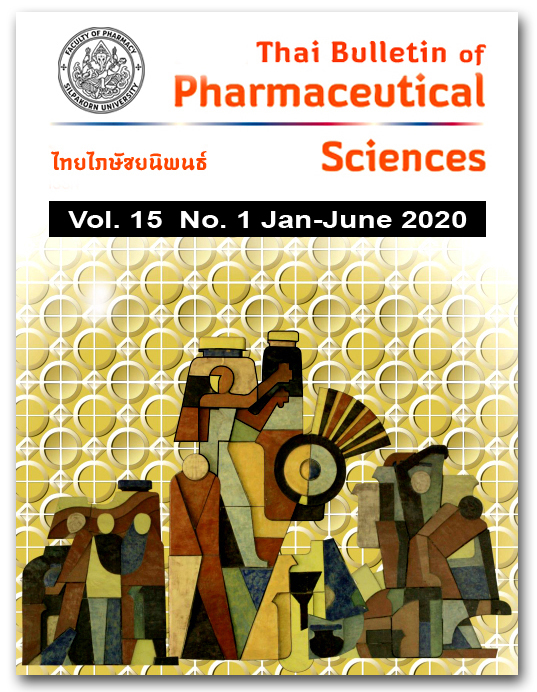EVALUATION AND MONITORING OF MEDICATION ERRORS AND DRUG RELATED PROBLEMS FROM ORAL INHALER DRUGS IN PATIENTS WITH ASTHMA AND CHRONIC OBSTRUCTIVE PULMONARY DISEASE AT SAWANPRACHARAK HOSPITAL
DOI:
https://doi.org/10.69598/tbps.15.1.31-47Keywords:
asthma, COPD, drug related problems (DRP), medication errors (ME), oral inhaler drugs, pharmaceutical careAbstract
The management of asthma and chronic obstructive pulmonary disease (COPD) requires continuous medication and a proper inhaler drug. A lack of knowledge and skill by numerous patients needed to operate the device is a significant hindrance to effective disease management. Pharmacists, therefore, have an important role to assess, follow up, and advise correct and continuous inhaler use, thus reducing medication errors as well as preventing and resolving drug utilization problems. In this study, data were collected prospectively. Pharmacists evaluated and followed up on-inhalation problems of 46 males with asthma and COPD while admitted to Sawanpracharak Hospital from March to June 2019. Objectives were to assess and solve drug-related problems and medication errors and compare the correct use of inhalation devices before and after receiving guidance from pharmacists’. 8 medication errors were detected and all were corrected by pharmacists. Additionally, 8 drug-related problems were detected and 7 were solved. The assessment of patients’ inhaler device handling techniques in percentages before and after (shown in brackets, respectively) receiving pharmacists’ guidance on the following topics were 1) dosage (52.18% and 82.61%), 2) proper device handling (41.30% and 95.65%), 3) oral cleansing after inhalation (80.43 and 97.83%), and 4) determining the remaining dosage (56.52% and 100.00%). All comparisons were statistically significant (p<0.01). Therefore, continuous evaluation and monitoring by pharmacists helps patients to correctly use inhaler devices, reducing both medication errors and drug related problems.
References
2. Centers for Disease Control and Prevention (CDC). Chronic obstructive pulmonary disease among adults - United States, 2011. MMWR Morb Mortal Wkly Rep. 2012;61(46):938-43.
3. Global Initiative for Chronic Obstructive Lung Disease (GOLD). Definition and overview. In: GOLD. Global strategy for the diagnosis, management, and prevention of chronic obstructive pulmonary disease (updated 2014) [Internet]. Fontana (WI): GOLD; 2014 [cited 2018 Nov 14]. p.1-7. Available from: https://www.korektorzdrowia.pl/wp-content/uploads/gold-2014.pdf
4. Committee on Development of Clinical Practice Guidelines for Chronic Obstructive Pulmonary Disease. Clinical practice guidelines for chronic obstructive pulmonary disease [Internet]. Bangkok: National Health Security Office; 2010 [cited 2018 Nov 14]. Available from: https://www.lpnh.go.th/newlp/wp-content/uploads/2013/10/แนวทางการรักษาโรคปอดอุดกั้นเรื้อรัง2553-Thaichest-ไทย.pdf (in Thai)
5. Wittheethamsak P. Relationship between symptom cluster and functional performance among chronic obstructive pulmonary disease patients [master's thesis]. Chonburi: Burapha University; 2010. (in Thai)
6. Krainara P, Malathum P, Nathisuwan S, Kawamatawong T. Self-care for medication use in older patients with chronic obstructive pulmonary disease. Rama Nurs J. 2011;17(2):287-304. (in Thai)
7. Promin J. Effects of dyspnea management promotion program on readmission and satisfaction of care among chronic obstructive pulmonary disease patients at Fang Hospital, Chiang Mai Province [master's thesis]. Chiang Mai: Chiang Mai University; 2008. (in Thai)
8. Preaphon N, Srisanpang S, Tippayanet N. The relationship between metered dose inhaler technique and exacerbation in COPD at the emergency room of Somdej Prabraromarachineenath Natavee Hospital. Community Health Dev Q KKU. 2013;1(2):47-57. (in Thai)
9. Batterink J, Dahri K, Aulakh A, Rempel C. Evaluation of the use of inhaled medications by hospital inpatients with chronic obstructive pulmonary disease. Can J Hosp Pharm. 2012;65(2):111-8.
10. Keeratichananont W, Thangsattayatisthan K. Assessment of patient’s inhalation technique in Songklanagarind Hospital: proportion of correct inhaler technique and influenced factors. Songkla Med J. 2012;30(4):189-97. (in ThaI)
11. Dolovich MB, Ahrens RC, Hess DR, Anderson P, Dhand R, Rau JL, et al. Device selection and outcomes of aerosol therapy: evidence-based guidelines: American College of Chest Physicians/American College of Asthma, Allergy, and Immunology. Chest. 2005;127(1):335-71.
12. Gustafsson P, Taylor A, Zanen P, Chrystyn H. Can patients use all dry powder inhalers equally well? Int J Clin Pract. 2005;59 Suppl 149:13-8.
13. Molimard M, Raherison C, Lignot S, Depont F, Abouelfath A, Moore N. Assessment of handling of inhaler devices in real life: an observational study in 3811 patients in primary care. J Aerosol Med. 2003;16(3):249-54.
14. Gilbert AL, Roughead EE, Beilby J, Mott K, Barratt JD. Collaborative medication management services: improving patient care. Med J Aust. 2002;177:189-92.
15. Bednall, R. Drug-related problems may bring thousands to A&E departments. Pharm J [Internet]. 2003 [cited 2018 Nov 14];270:359. Available from: https://www.pharmaceutical-journal.com/pj-online-news-drug-related-problems-may-bring-thousands-to-ae-departments/20009007.article
16. Leape LL, Cullen DJ, Clapp MD, Burdick E, Demonaco HJ, Erickson JI, et al. Pharmacist participation on physician rounds and adverse drug events in the intensive care unit. JAMA. 1999;282(3):267-70.
17. Pongpradit M. Project for the development of the quality of the inpatient medical service system [Internet]. Nakhon Sawan: Nongbua Hospital; 2014 [cited 2019 Feb 14]. Available from: https://nbhosp.thaiddns.com/nb/ download/HA/แผนกลยุทธ์ HA 2557/4-KPI Template-HA-2557.doc (in Thai)
18. Hansittiporn K. The result of setting up an easy asthma clinic in Chiang Yuen Hospital Mahasarakham Province. Srinagarind Med J 2012;27(2):167-71. (in Thai)
19. Pansa S, Srichada P, Siwaborwornwattana A, Tedrapeemetawenumchai S. Improved clinical outcomes in asthmatic and COPD inhaler users with multimedia-acquired pharmacy counseling. J Health Sci. 2016;25(3):436-45. (in Thai)
20. Patarawatanaporn Y. The Effects of the Participatory Learning Program of using Meter-Dosed Inhaler drugs in Asthmatic Clinic [Internet]. Nakhon Nayok: Faculty of Medicine, Srinakharinwirot University; 2015 [cited 2018 Nov 14]. p.95. Available from: https://med.swu.ac.th/th/ images/manuscript58.pdf (in Thai)
21. Phanphao W, Jenghua S, Supamoon W, Nakham A. Intervention on managing drug related problems in hospitalized patients with asthma and chronic obstructive pulmonary disease (COPD) in Buddachinnaraj Phitsanulok Hospital. Naresuan University J. 2005;13(1):51-9. (in Thai)
Downloads
Published
How to Cite
Issue
Section
License
All articles published and information contained in this journal such as text, graphics, logos and images is copyrighted by and proprietary to the Thai Bulletin of Pharmaceutical Sciences, and may not be reproduced in whole or in part by persons, organizations, or corporations other than the Thai Bulletin of Pharmaceutical Sciences and the authors without prior written permission.



